The UEFA Champions League is back. On Tuesday, all eyes were on Parc des Princes to watch one of the toughest games in the first leg of the 16 round between Paris Saint-Germain and Bayern Munich.
The Bavarians, who dominated the game for the most part, earned a 1-0 win over PSG. The Frenchman Kingsley Coman scored the only goal, such as he did three years ago when both teams met in the Champions League final.
This tactical analysis will dive into the tactics of both teams, also how Julian Nagelsmann dominated Christophe Galtier tactically and was ready for his reactions.
Lineups
The French coach Christophe Galtier structured his team in 4-4-2 which has been used for only 7% of the games this season.
Paris Saint-Germain’s starting eleven comprised of: Donnarumma; Hakimi, Ramos, Marquinhos (c), Mendes; Zaire Emery, Pereira, Verratti, Soler; Messi, Neymar.
On the other side, the 35-year-old coach Julian Nagelsmann lined up his players in a 3-4-2-1 dynamic structure.
Bayern Munich‘s starting lineup was as follows: Sommer; Pavard, Upamecano, De Ligt; Cancelo, Kimmich (c), Goretzka, Coman; Sane, Musiala, Choupo-Moting.
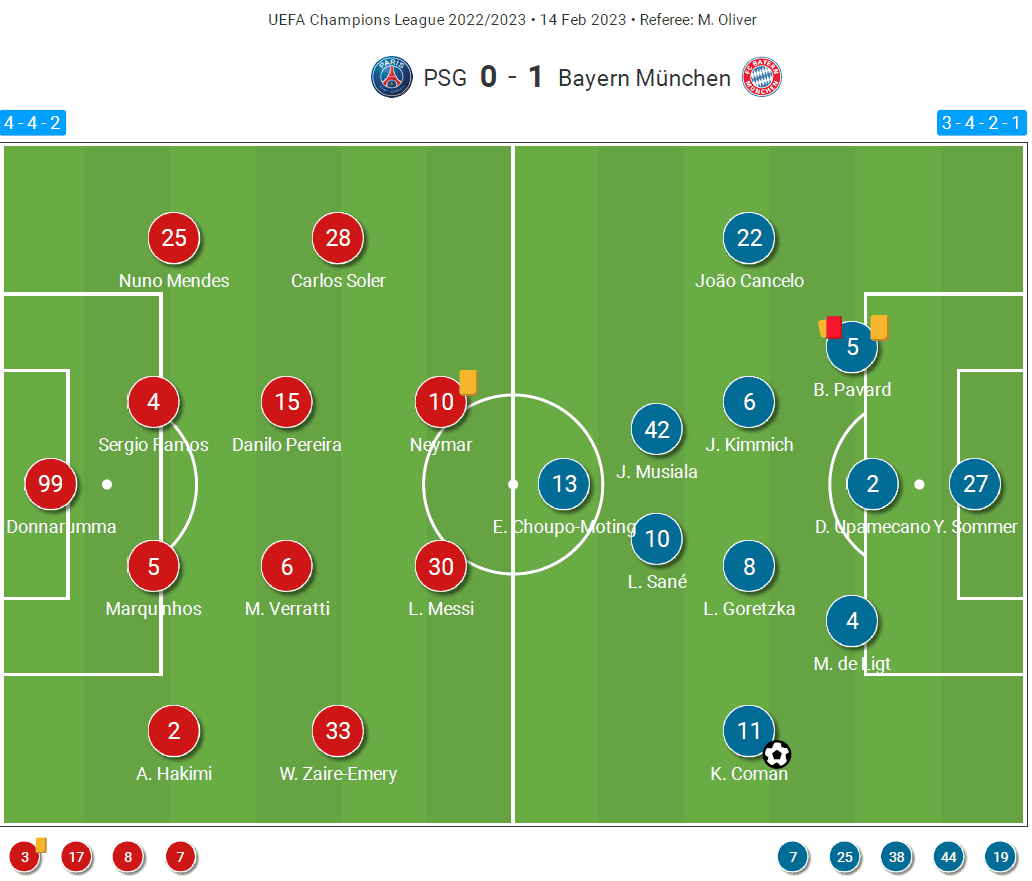
Bayern’s glow vs PSG’s suffering?
Bayern mostly dominated the play against a cautious retreat from Paris in their stadium, which didn’t enable us to see Yann Sommer much in the first half.
Usually, Nagelsmann is diverting between some in-possession structures under the same principles. Seeking the vertical axis more than the horizontal one could summarise his positional play approach.
His prominent idea is usually attempting to have fluidity, gaining superiority in each part of the pitch and having players occupy offensive zones to create combinations or attack the backline with vertical and diagonal deep runs.
Against Galtier’s compact 4-4-2 block, Nagelsmann had used a dynamic 3-1-5-1 shape, building with a 3-1 base to have the advantage over the first line.
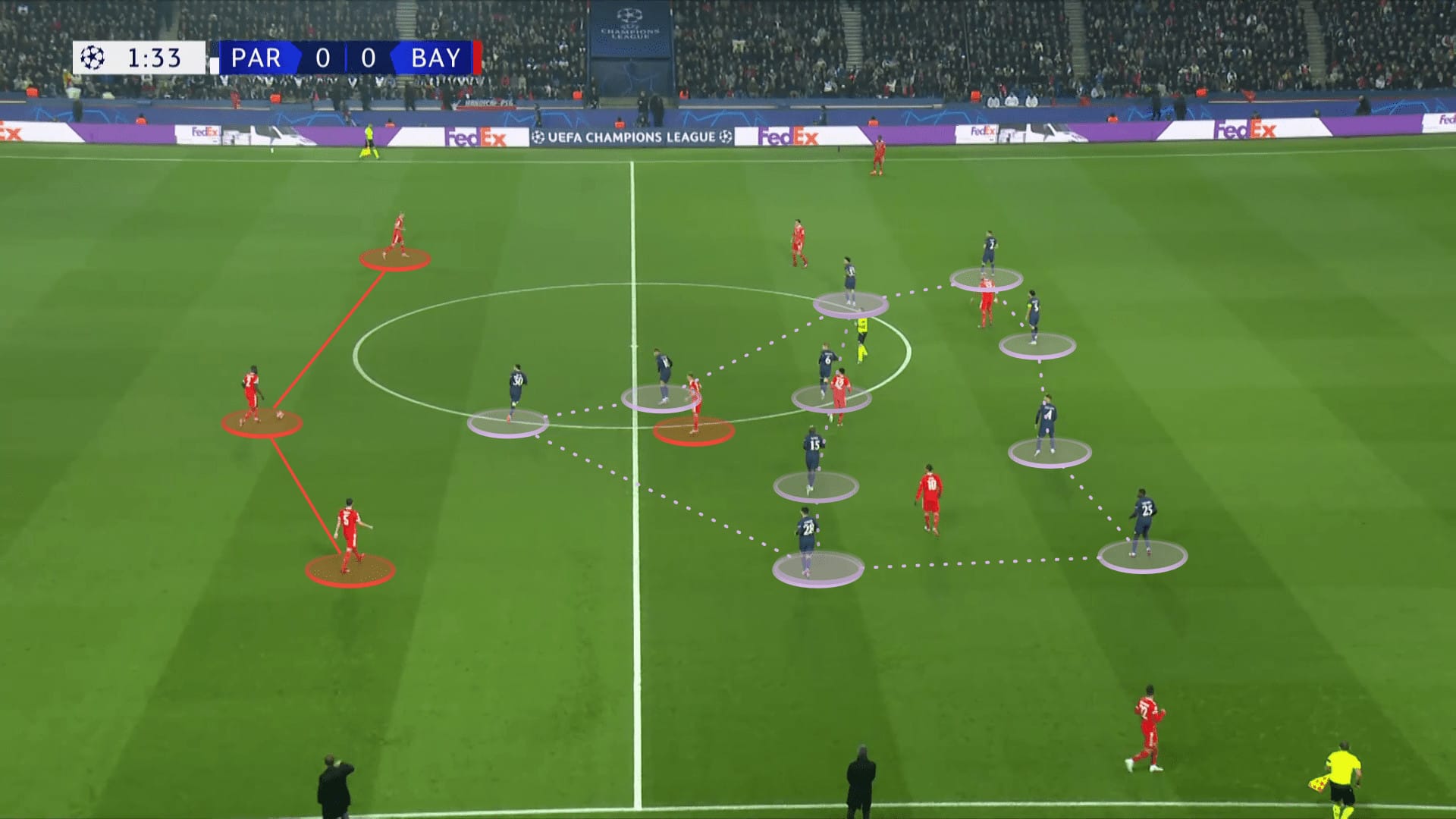 Bayern are using a 3-1-5-1 shape vs 4-4-2 PSG’s compact defensive structure
Bayern are using a 3-1-5-1 shape vs 4-4-2 PSG’s compact defensive structure
While starting with the proper nine Choupo-Moting, Sane and Goretzka pushed up to both half-spaces. The two wing-backs Cancelo and Coman were out wide. Musiala played as a roaming No.10 and his positioning varied between being on the same vertical or horizontal line with Choupo-Moting.
Nagelsmann preferred this time for stretching the opposition to use Cancelo on the right side and Coman on the opposite side with his dominant foot. To manipulate this compact defensive structure, Bayern utilised some tricks.
With his vertical philosophy. Nagelsmann showed a clear plan to keep the ball on one side, utilising triangles or diamonds, attempting to drag the block and then switch the play to the weak side, creating a 1v1 on a big space.
The right side was preferred with late support from the movable right centre-back Pavard who joined a lot of the wide combinations with Cancelo to overload.
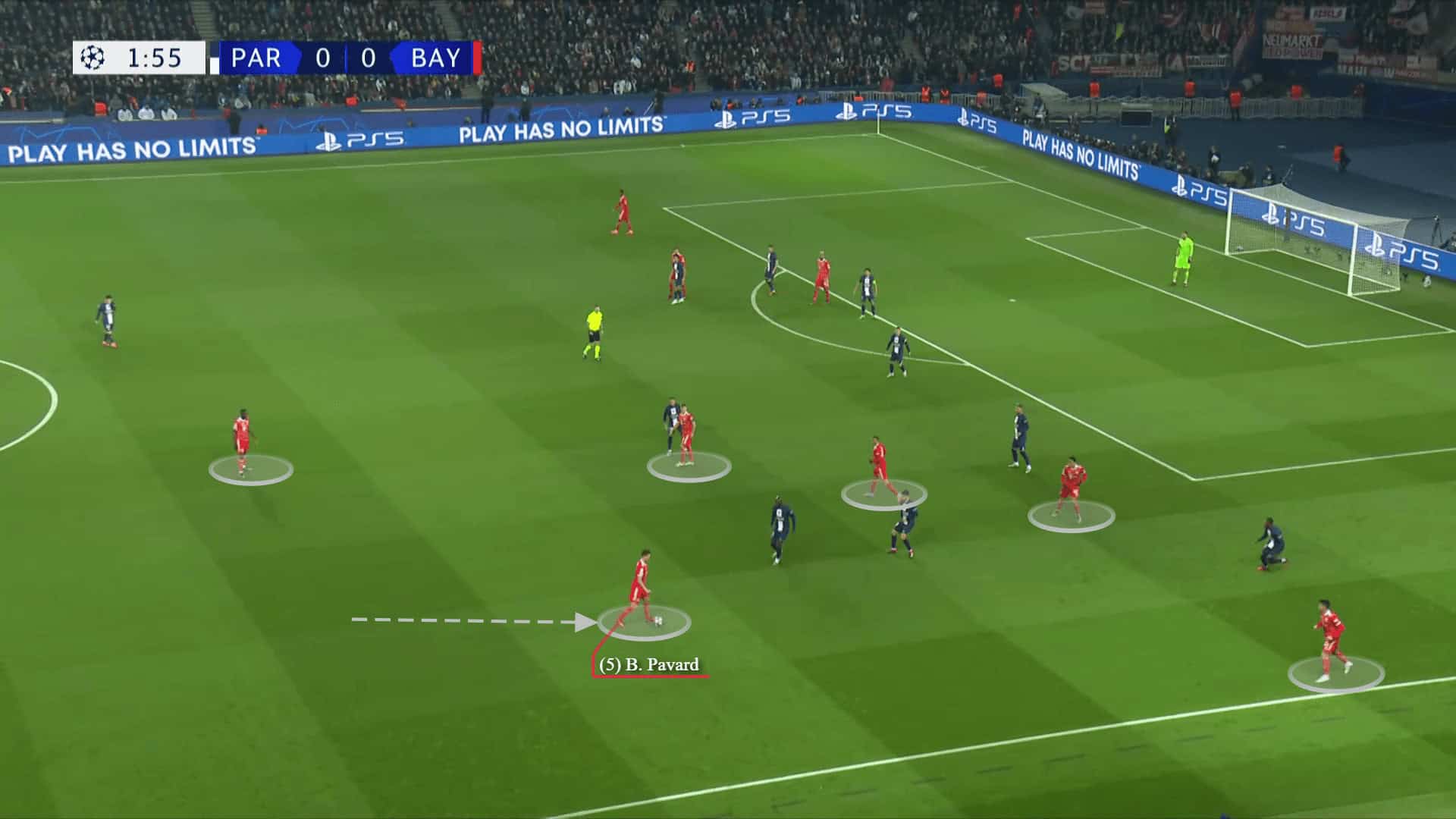 Pavard is pushing forward while Bayern’s players overloading the right-hand side
Pavard is pushing forward while Bayern’s players overloading the right-hand side

Bayern frequently used Kimmich or Pavard as relay players to circulate and switch the ball diagonally above the block. Meanwhile, the vertical run of Goretzka in the left interior corridor had confused Hakimi.
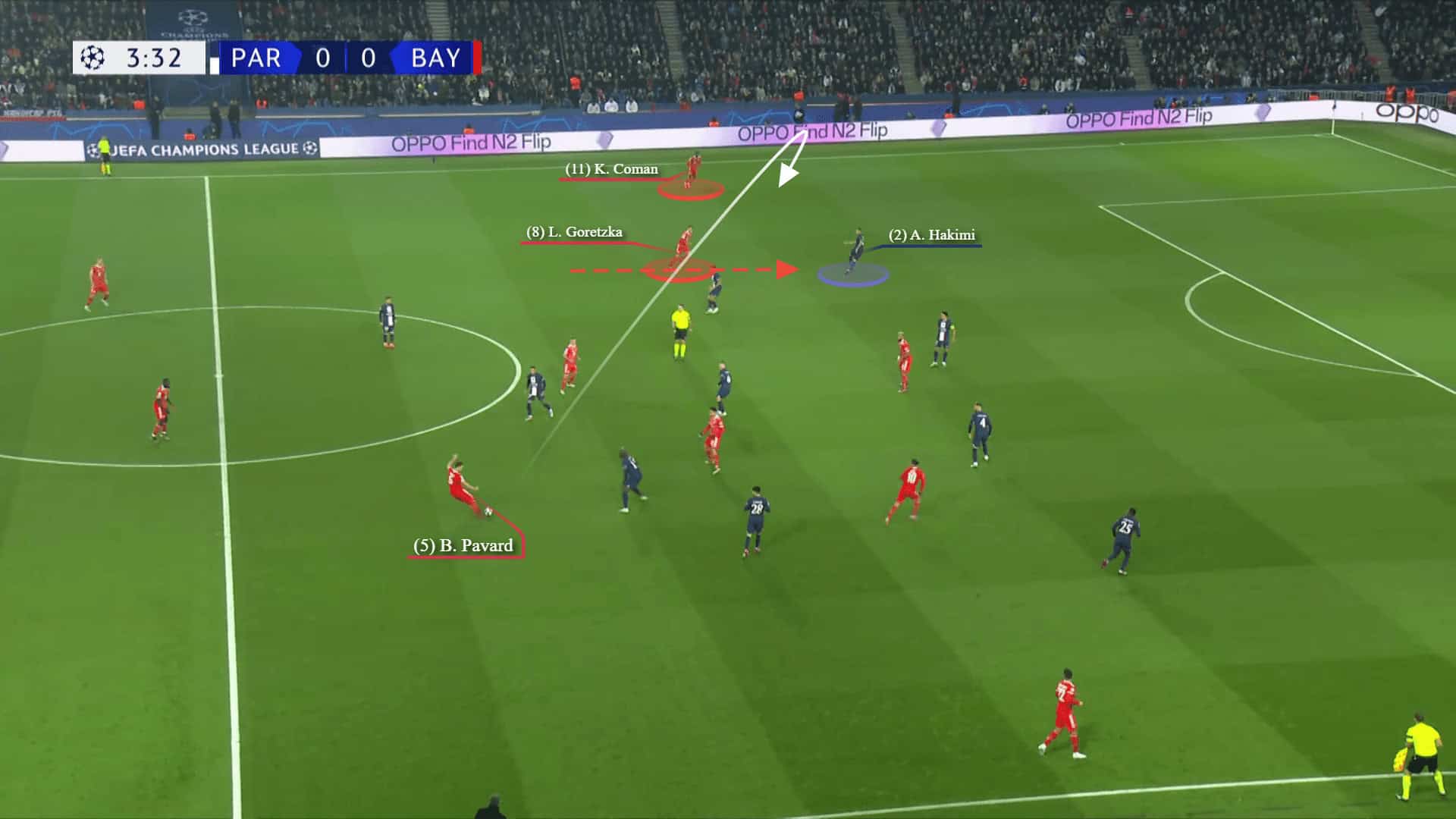 Pavard is playing a long diagonal pass to Coman meanwhile Goretzka’s vertical run is confusing Hakimi
Pavard is playing a long diagonal pass to Coman meanwhile Goretzka’s vertical run is confusing Hakimi
This attitude was infrequently also used from left to the right in the first half under the same conception yet Coman was unpredicted for the fullback more because of his wrong foot usage. Coman varied between going inside to shoot or hugging the line to cross.
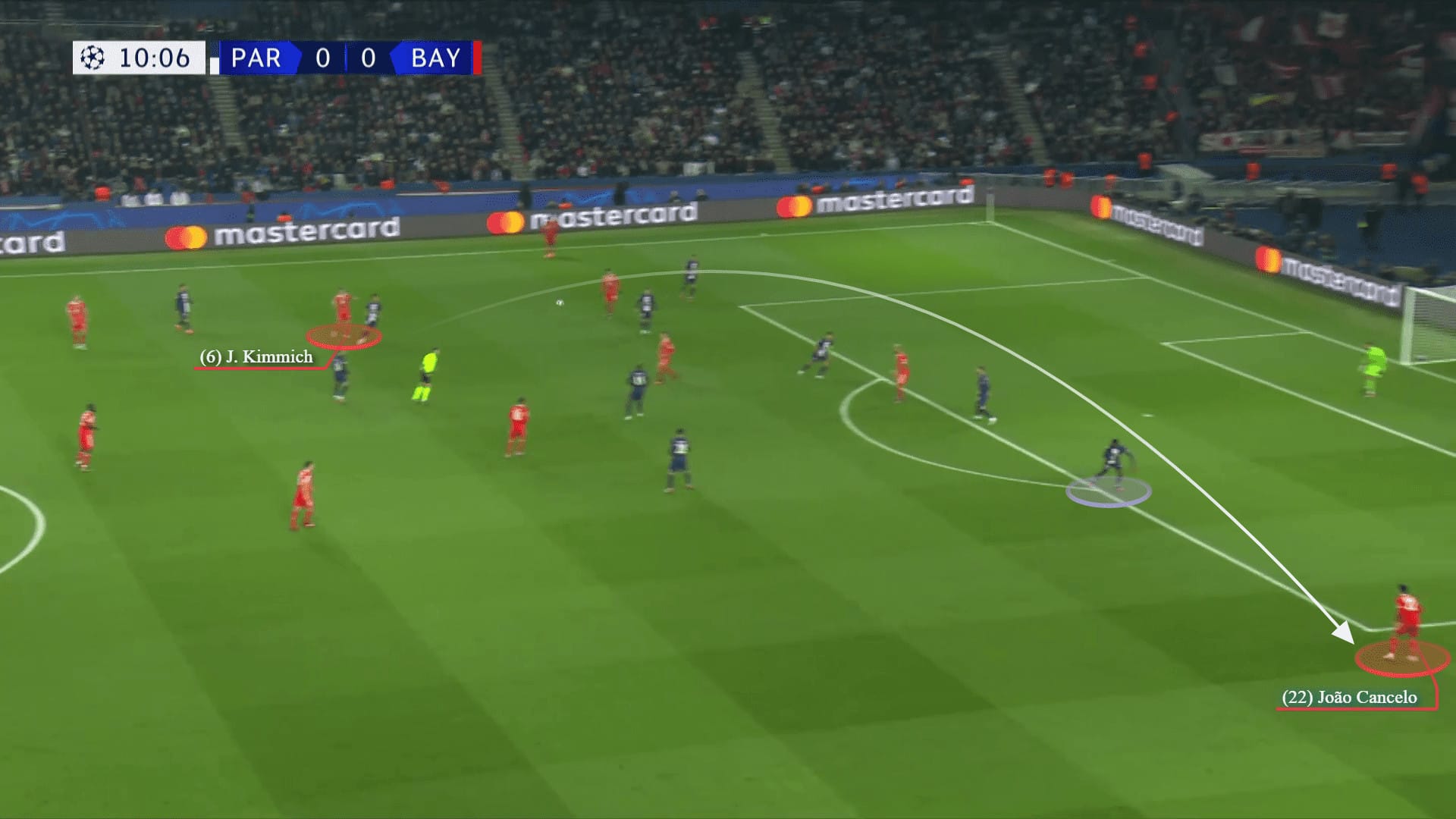 Kimmich is playing the diagonal above the defensive block to put Cancelo in 1v1
Kimmich is playing the diagonal above the defensive block to put Cancelo in 1v1
In the scene below, when the ball was on the side, Bayern’s players started to attack PSG’s box with sudden vertical and diagonal runs waiting for the cross, the goal came from the same idea later. Also here, Cancelo didn’t ready to attack the far post like Coman in the goal scene.
 Bayern’s players are attacking PSG’s box with sudden deep runs
Bayern’s players are attacking PSG’s box with sudden deep runs
Due to the less pressure of Messi and Neymar in the first line of PSG’s defensive block, Bayern’s centre-backs had the space to carry the ball forward and correspondingly attempted to break through by executing central 1-2s and third-man combinations.
These vertical passes from the centre-backs to the positional players in between lines primarily provoked the defenders to step up to press and leave spaces that could be exploited.
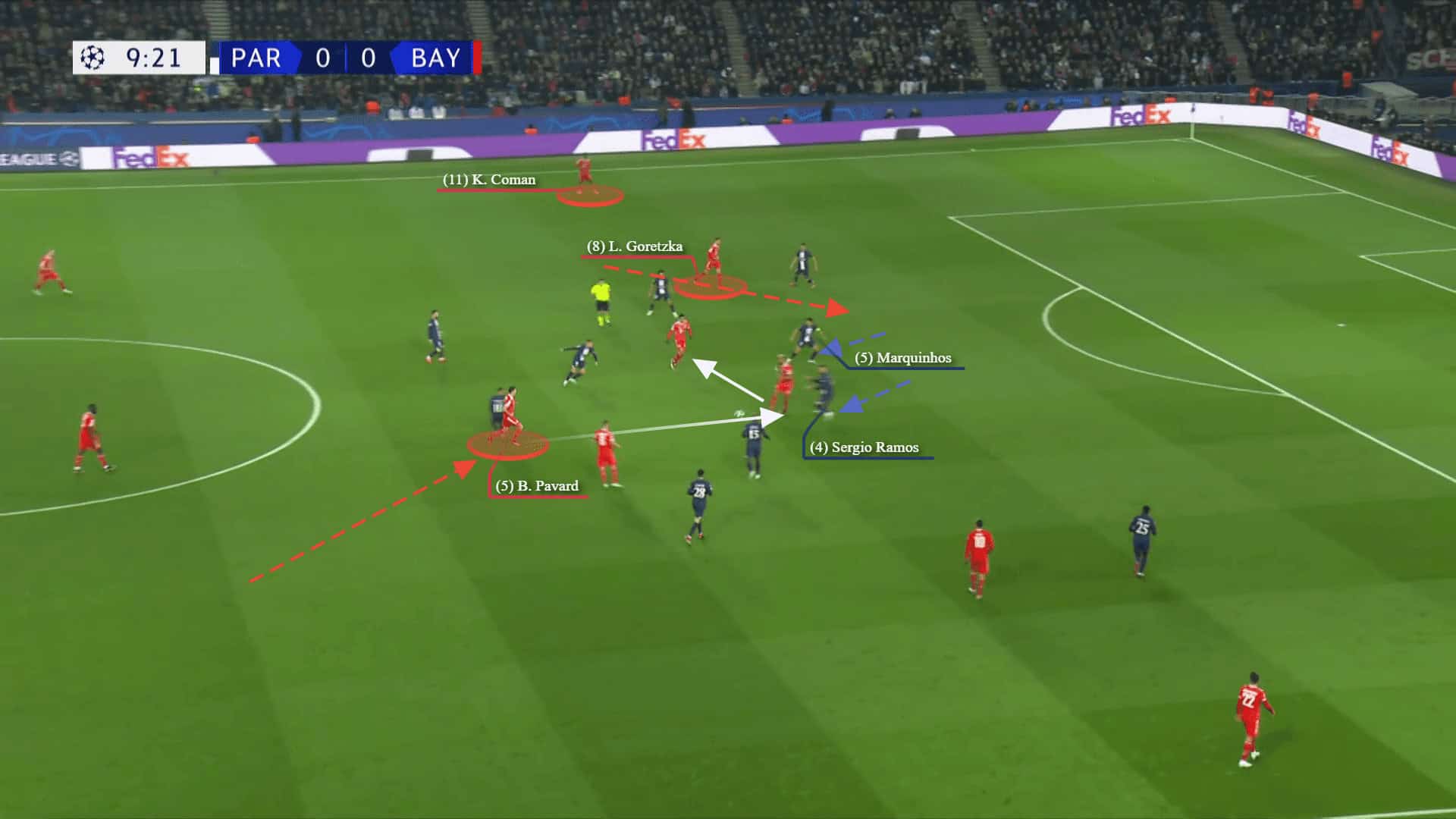 Jamal Musiala is receiving the 3rd man combination meanwhile Goretzka is intending to exploit the space behind the backline
Jamal Musiala is receiving the 3rd man combination meanwhile Goretzka is intending to exploit the space behind the backline
Furthermore, once Paris Saint-Germain were forced deep into their half, Bayern continued their attitude of running behind the backline with deep movements.
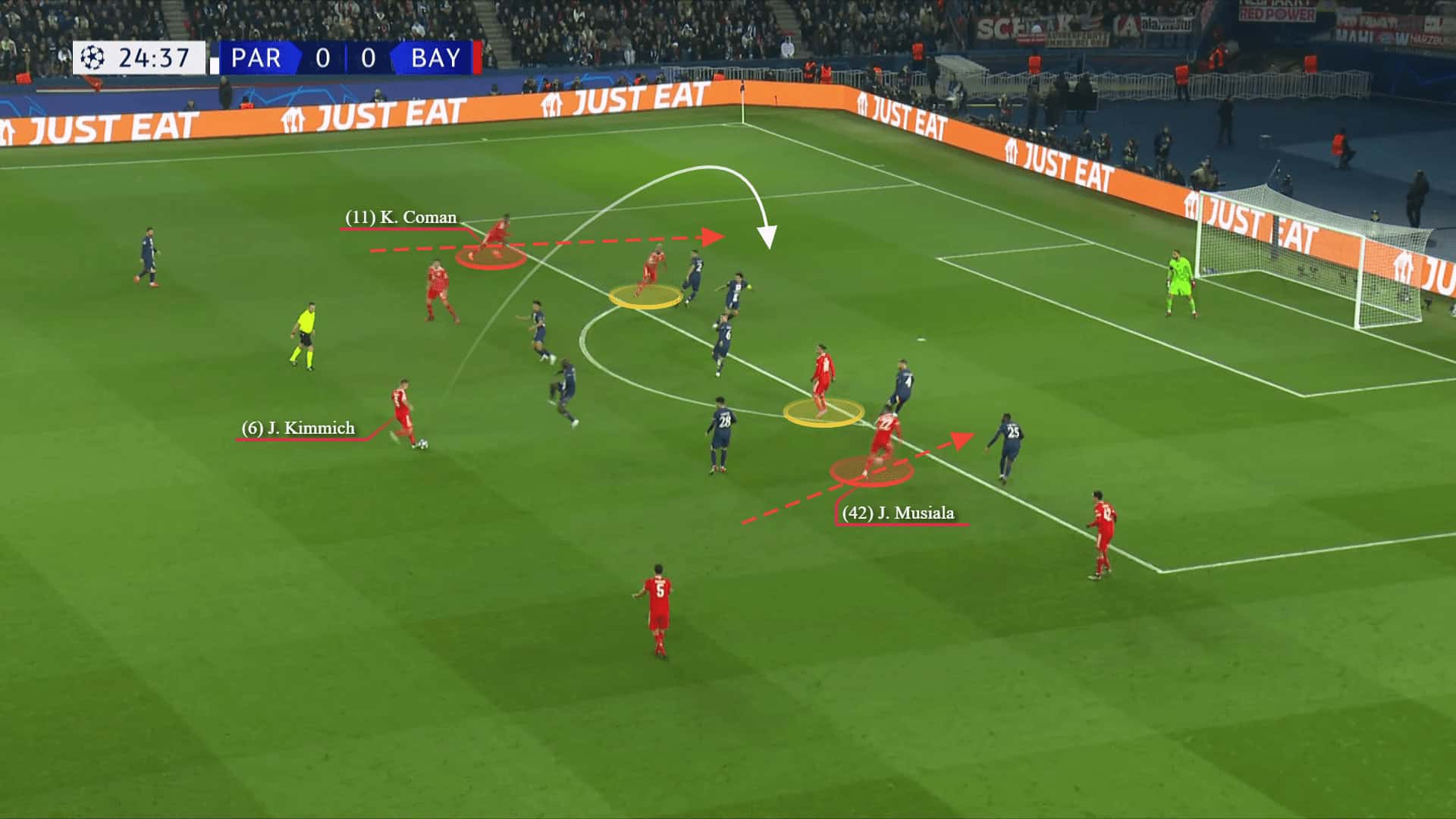 While Choupo-Moting and Sane are pinning the backline, Musiala and Coman are doing deep runs behind waiting for Kimmich’s through pass
While Choupo-Moting and Sane are pinning the backline, Musiala and Coman are doing deep runs behind waiting for Kimmich’s through pass
Bayern totally dominated PSG also because of their counter-pressing approach. Their in-possession structure, and having a numerical advantage on the different lines offered them that advantage.
They regained the ball back quickly and they had 17 counter-pressing recoveries within five seconds after a possession loss. PSG had 11.
In this aspect, below, this forward vertical pass, though it’s risky to lose, has benefits. Bayern followed it with aggressive counter-pressing.
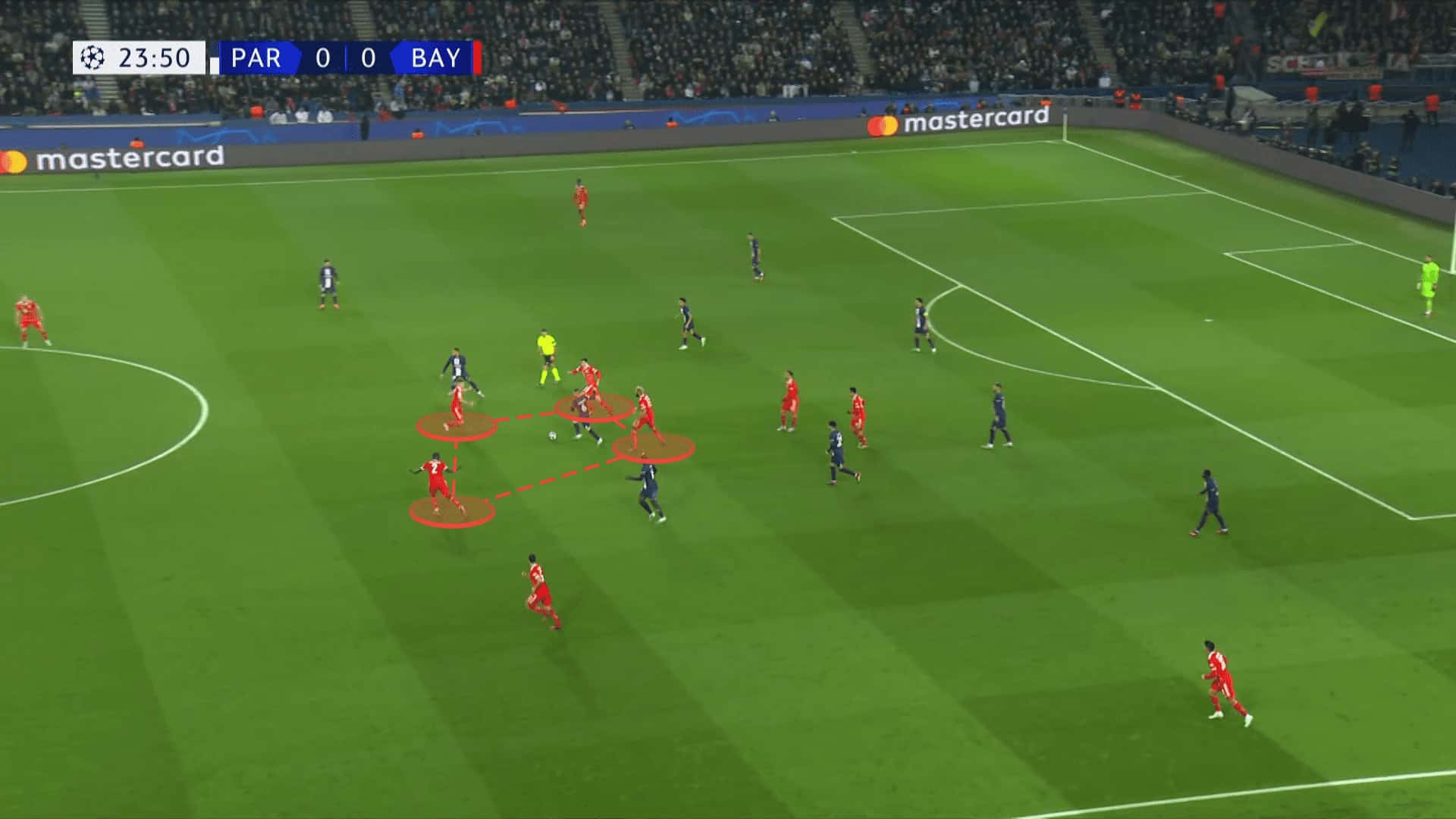 After losing the ball, Bayern’s players are counter-pressing well to get it back higher
After losing the ball, Bayern’s players are counter-pressing well to get it back higher
Furthermore, It is dangerous to play against a possible counterattack, which has Messi and Neymar, by this rest defence positional structure.
Correspondingly, Pavard was pushing forward on the right side. The rest defence shape had varied between 3-1 to 2-2 forms which would be changing later after Kylian Mbappé came on.
 Bayern’s rest defence shapes varied between 3-1 to 2-2
Bayern’s rest defence shapes varied between 3-1 to 2-2
Generally, the defenders did a top-level game, especially Dayot Upamecano who won 12 duels out of 18.
Football is an interconnected sport. To dominate a team such as those that are excellent in possession, you should have a solid defensive approach.
That would bring us to the pressing approach that Naglesmann utilised to press Galiter high.
Bavarians’ high-pressing approach
First and foremost, Christophe Galtier attempted to build up in a 4-2 base involving Donnarumma to beat the first line of Bayern’s press. With the central presence of Pereira and Verratti, the wide midfielders had pushed high and wide to the last line.
On the flip side, Naglesmann had used an active 3-2-3-2 high-pressing scheme which was risky because that’s mean leaving the backline in 4v4 or 3v3 situations.
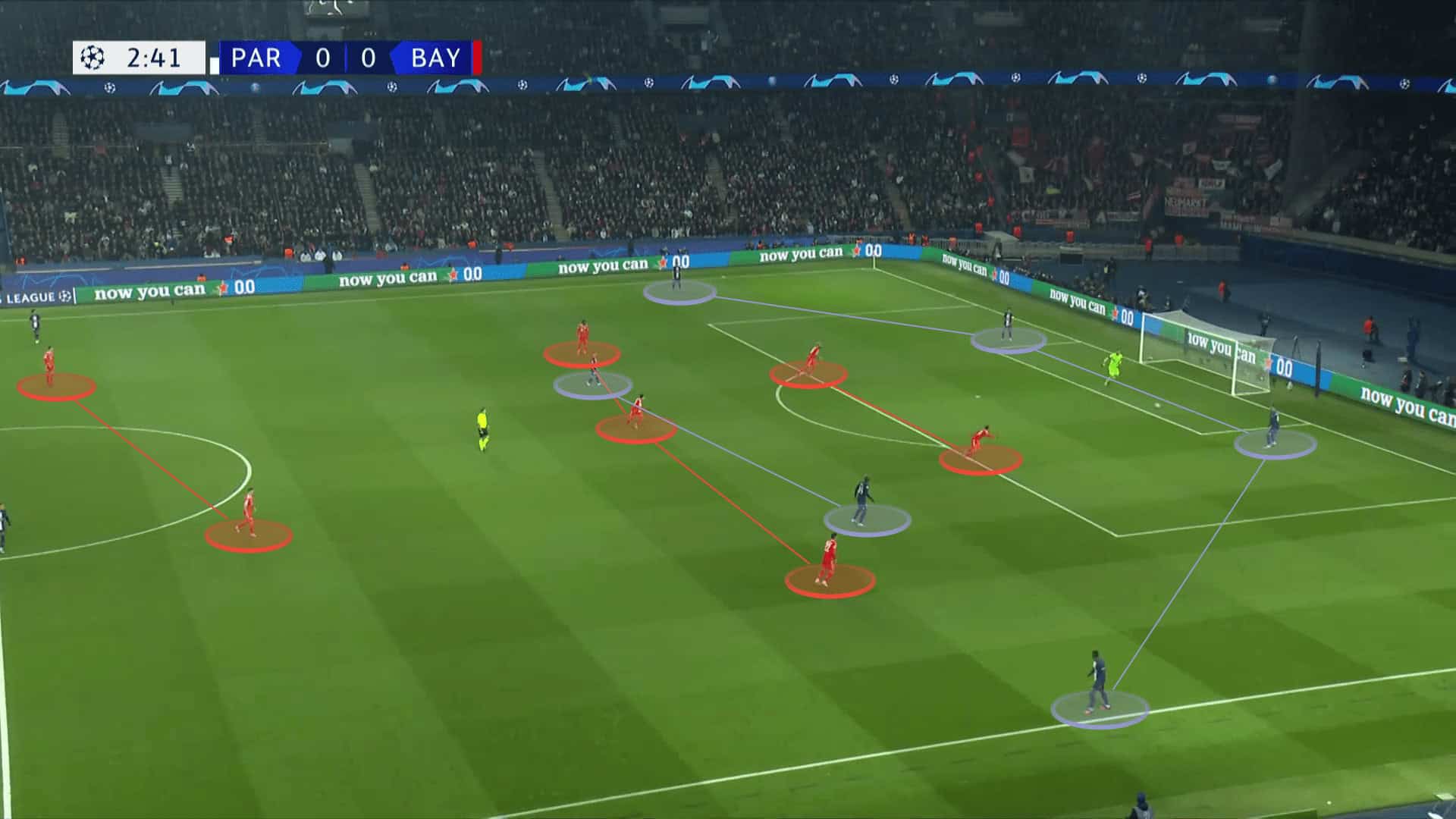 Naglesmann is utilising a 3-2-3-2 high-pressing scheme against Galtier’s 4-2 build-up base
Naglesmann is utilising a 3-2-3-2 high-pressing scheme against Galtier’s 4-2 build-up base
Sane and Choupo-Moting in the first line of the press did a decent job of putting PSG’s double pivot in their shadow.
Once the ball was reaching the fullback, the side was trapped and Bayern used the sideline as an extra defender very well.
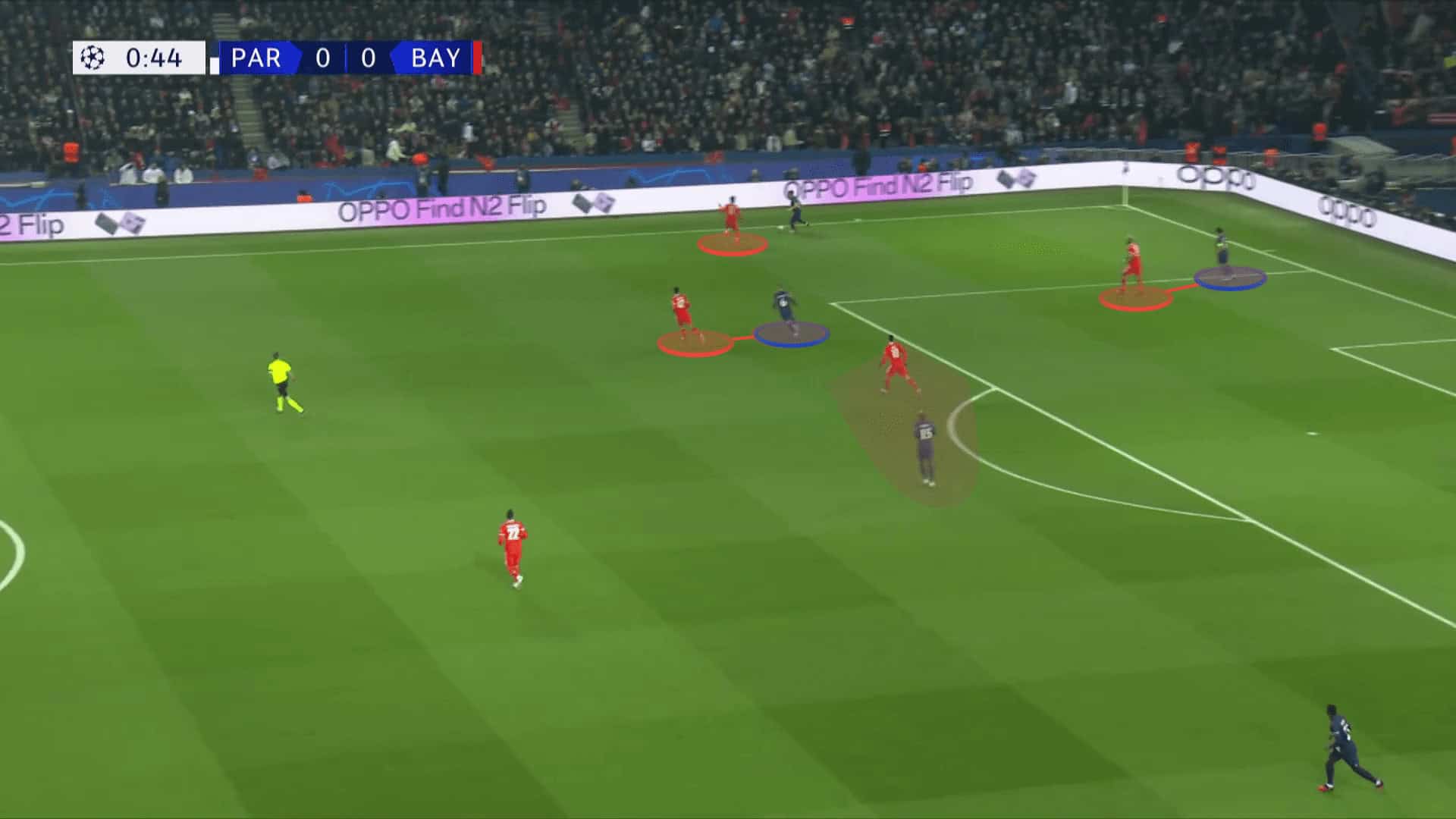 Bayern are trapping PSG on the side by using the sideline as an extra defender
Bayern are trapping PSG on the side by using the sideline as an extra defender
Nothing was on for PSG’s players except playing long ball toward the last line to Messi and Neymar, yet obviously, Bayern’s defenders were totally dominant in the aerial duels or even the ground duels.
PSG’s building missed the central density and Bayern’s high pressure was very efficient which forced PSG to react.
After that Pereira and Verratti attempted to drop between the two centre-back who stretched the line which created a 3v2 overload and gave them the room to carry the ball forward.
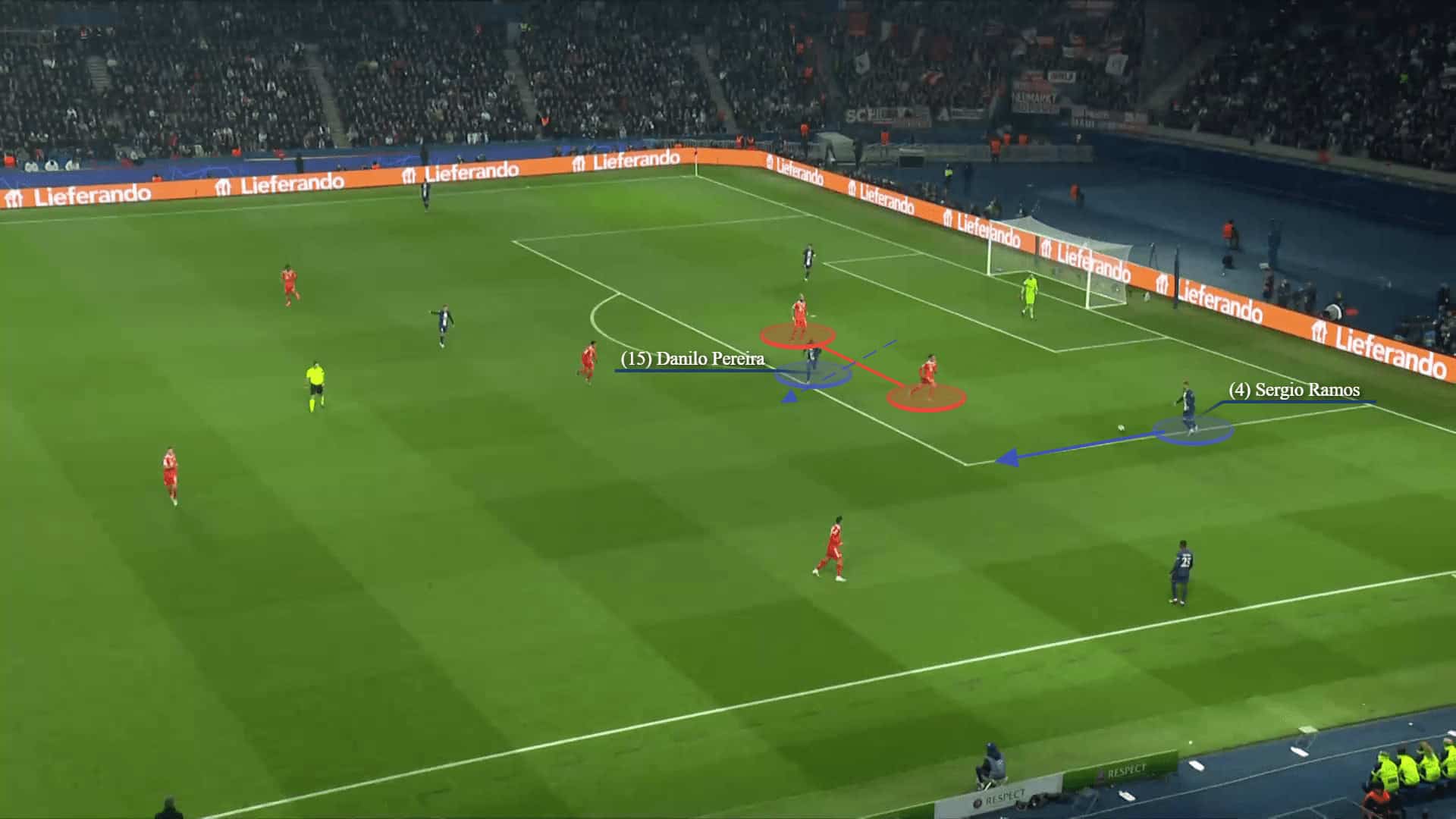 Pereira dropped to create a 3v2 which is giving Ramos room to carry the ball into the space
Pereira dropped to create a 3v2 which is giving Ramos room to carry the ball into the space
Furthermore, when Messi had dropped as an extra option to combine, De Ligt reacted well and pushed up to avoid this pattern.
 De Ligt is reacting to Messi’s dropping deeper to combine
De Ligt is reacting to Messi’s dropping deeper to combine
And once Christophe Galtier changed the structure, Messi’s initial position changed to a deeper position. Likewise, with Soler, they were in the same horizontal line.
Bayern had reacted well. Instead of Goretzka, De Ligt moved to the left to mark Zaire-Emery. Meanwhile, Goretzka pushed forward close to Leo. Furthermore, Kimmich became closer.
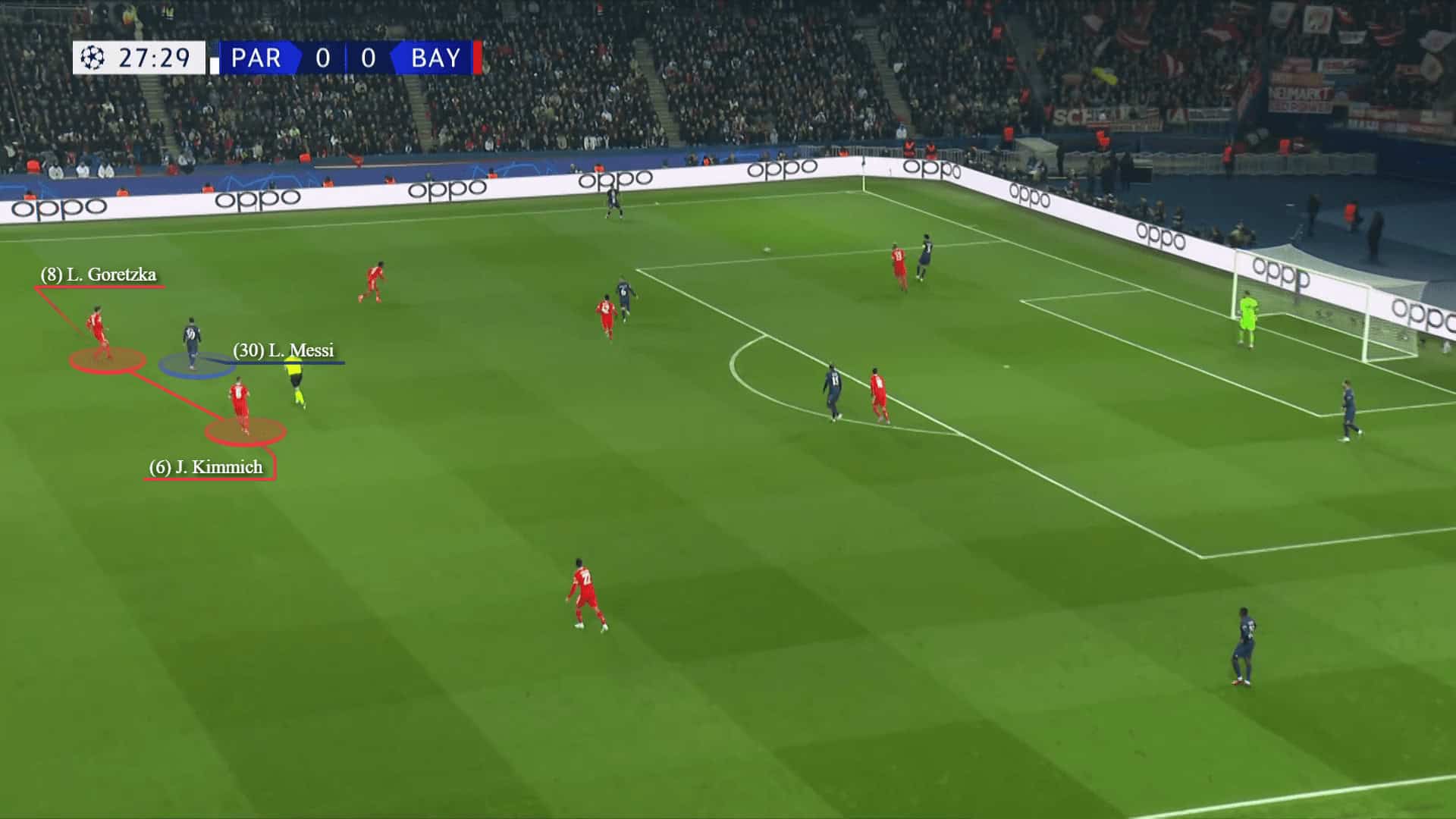 Bayern changed some instructions. Goretzka and Kimmich become closer to Leo
Bayern changed some instructions. Goretzka and Kimmich become closer to Leo
PSG attempted to benefit from Verratti’s brilliant press-resistant ability to penetrate but at least in the first half, that wasn’t enough to break the press.
Generally, the Bavarians’ distinction was evident in PPDA metrics. Bayern had 8.26 while Paris had 23.63. The lower the better.
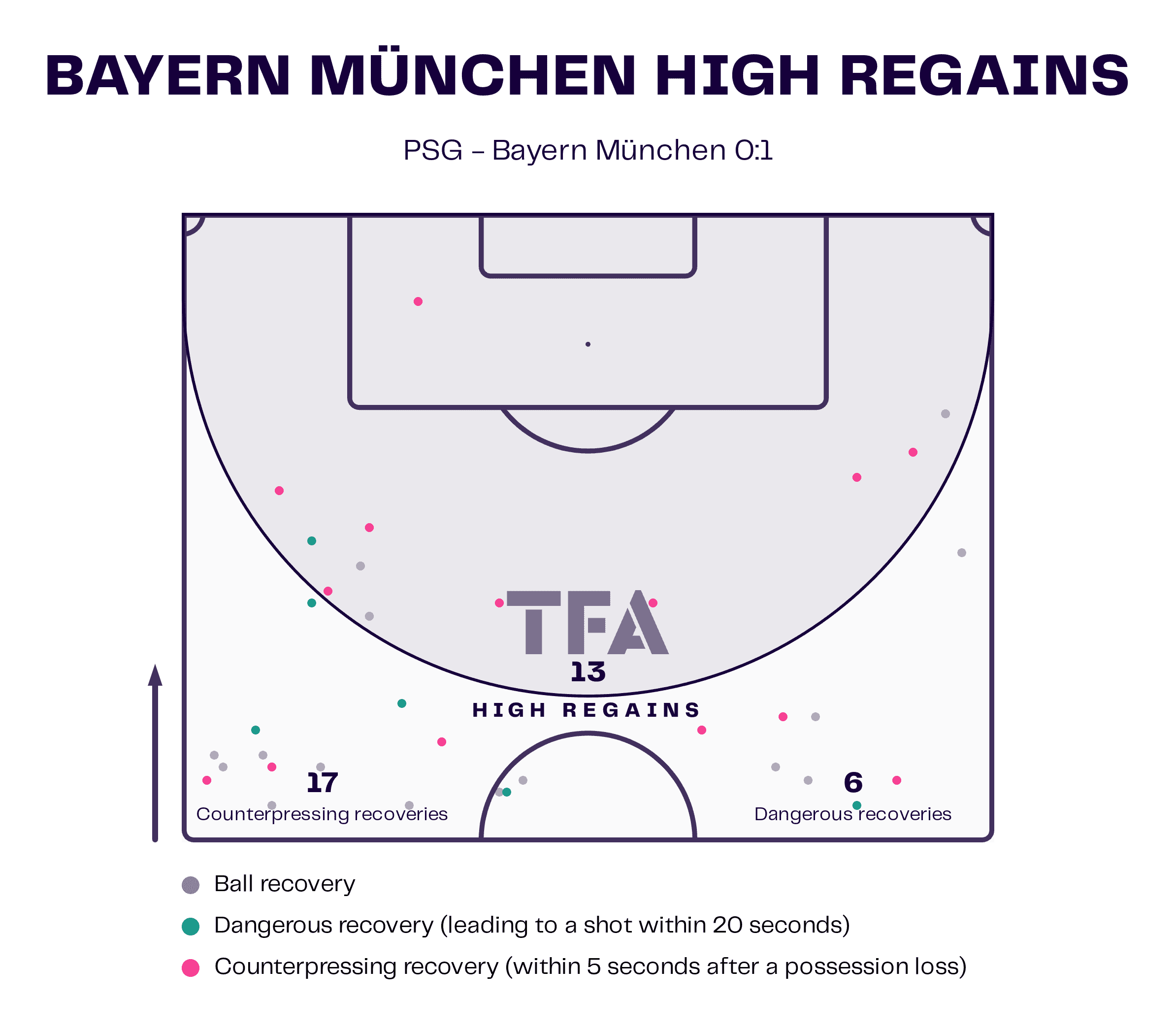
in the second half after the goal, Bayern’s pressure intensity decreased which came with PSG’s transformation to 4-3-3 with the substitutions from Galtier.
There was a substitution about to change everything, but who?
Mbappe’s impact & Naglesmann’s reaction
At 58:56, two minutes after Mbappe’s substitution, Naglesmann ordered his defenders to switch their positions in the backline reacting to the pace of Mbappe and Mendes that became on the left side.
Upamecano changed to right centre-back, De Ligt was playing in the centre and Pavard moved to the left. Upamecano is the relatively fastest of them and also knows his countryman well. Furthermore, Dayot has better use of body dynamics between them.
PSG transformed into a dynamic 4-3-3 with the free movement of Messi and Neymar which maybe provoked the defenders to push up. Then, spaces were generated behind them for Mbappe to exploit.
In the below scene, while Messi and Neymar dropped deeper, De Ligt and Upmecano were being forced into a deeper central zone close to Mbappe.
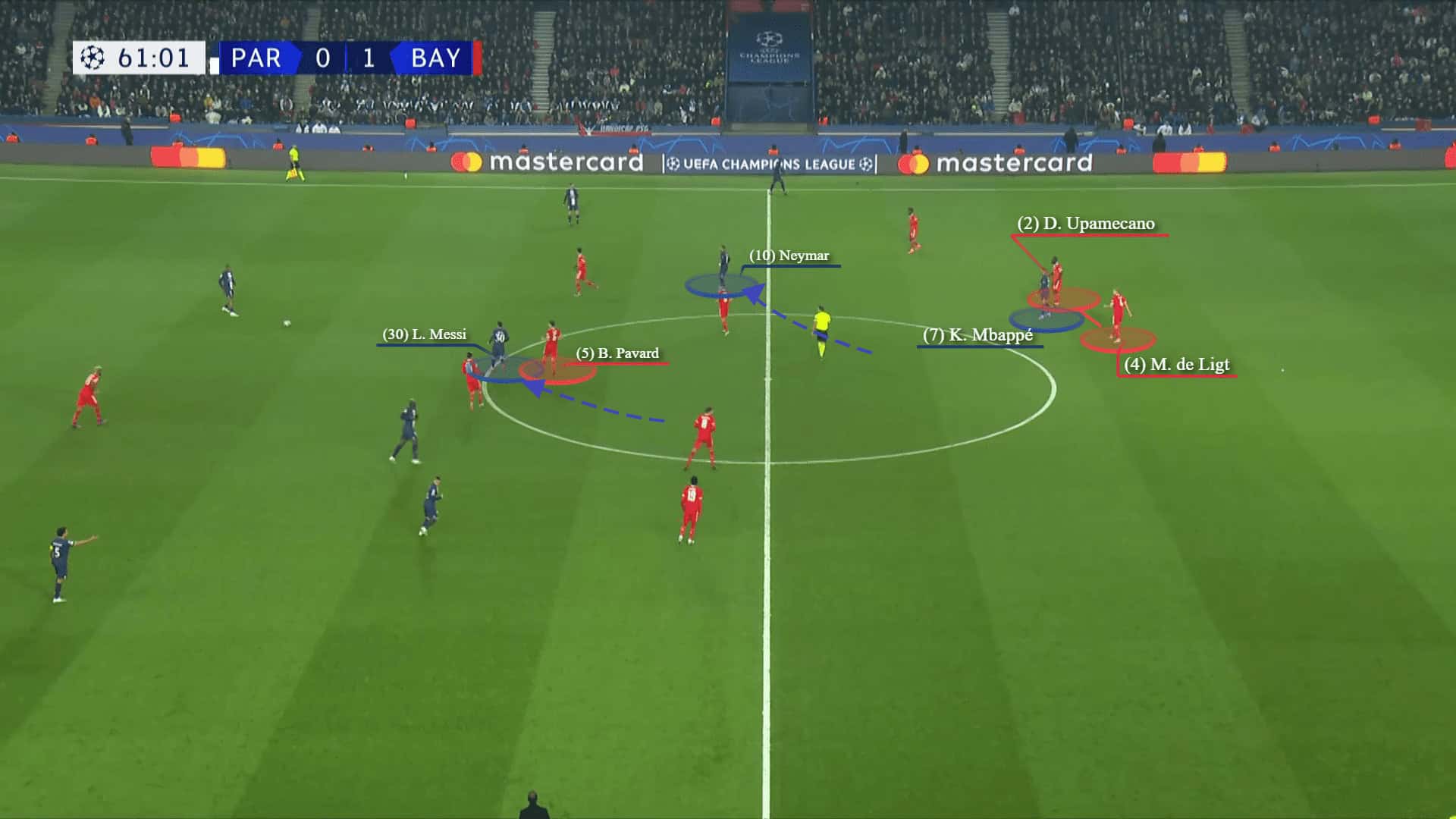 Messi and Neymar have more freedom while De Ligt and Upamecano are being closer to Mbappe
Messi and Neymar have more freedom while De Ligt and Upamecano are being closer to Mbappe
The rest defence had been changed to contrast Mbappe to man-to-man and Upamecano was being close as possible to him with an awareness of any possible in-behind runs.
 Upamecano is using a man-marking approach against Mbappe
Upamecano is using a man-marking approach against Mbappe
In the below graphic, Mbappe was about to score to level the game. He received in the blindside of Coman, meanwhile, Upamecano stepped forward to face Neymar.
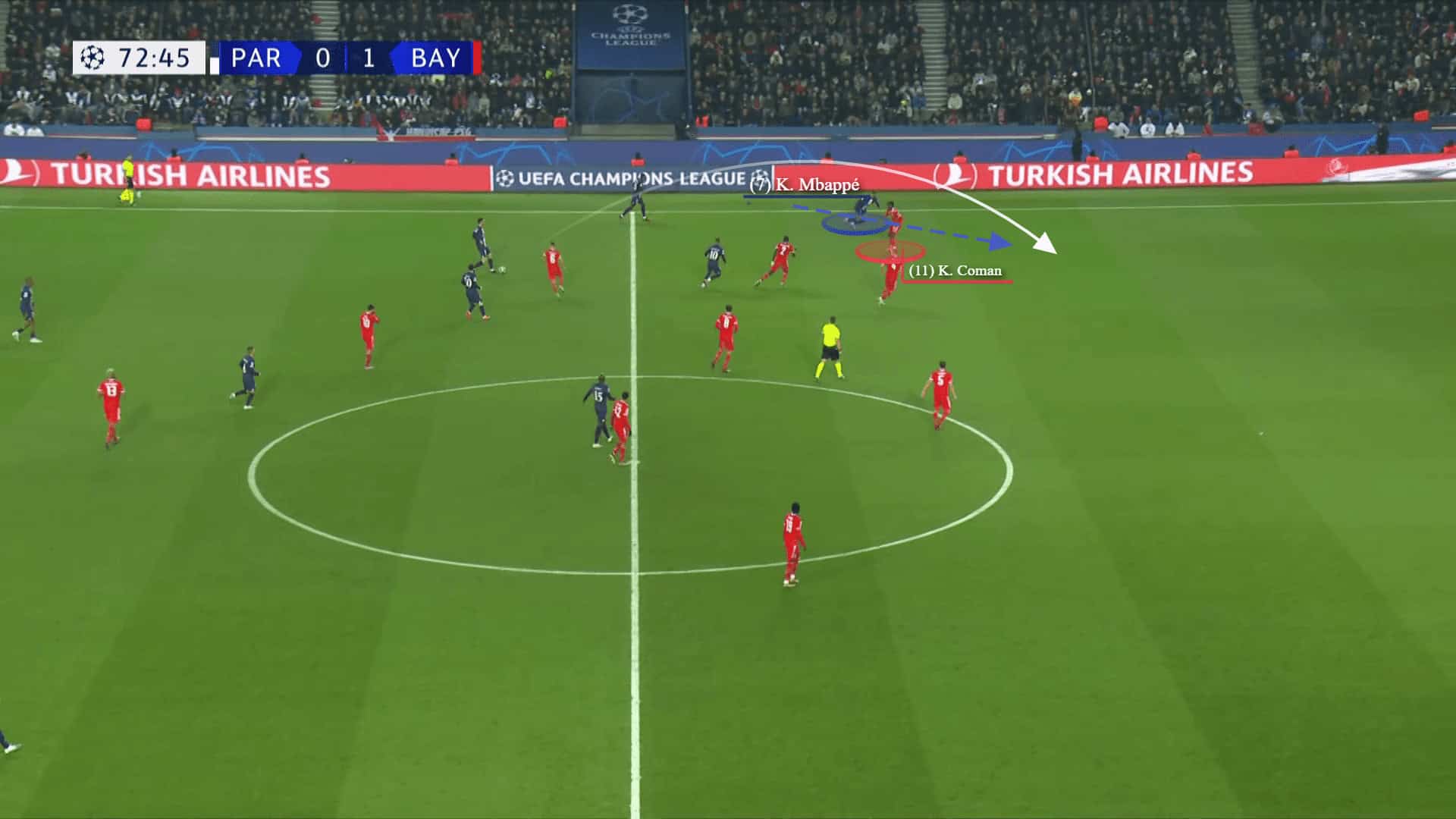 Mbappe is running in the blindside of Coman waiting for the through pass
Mbappe is running in the blindside of Coman waiting for the through pass
Before the end, Bayern had retreated to a 5-3-2 central defensive block.
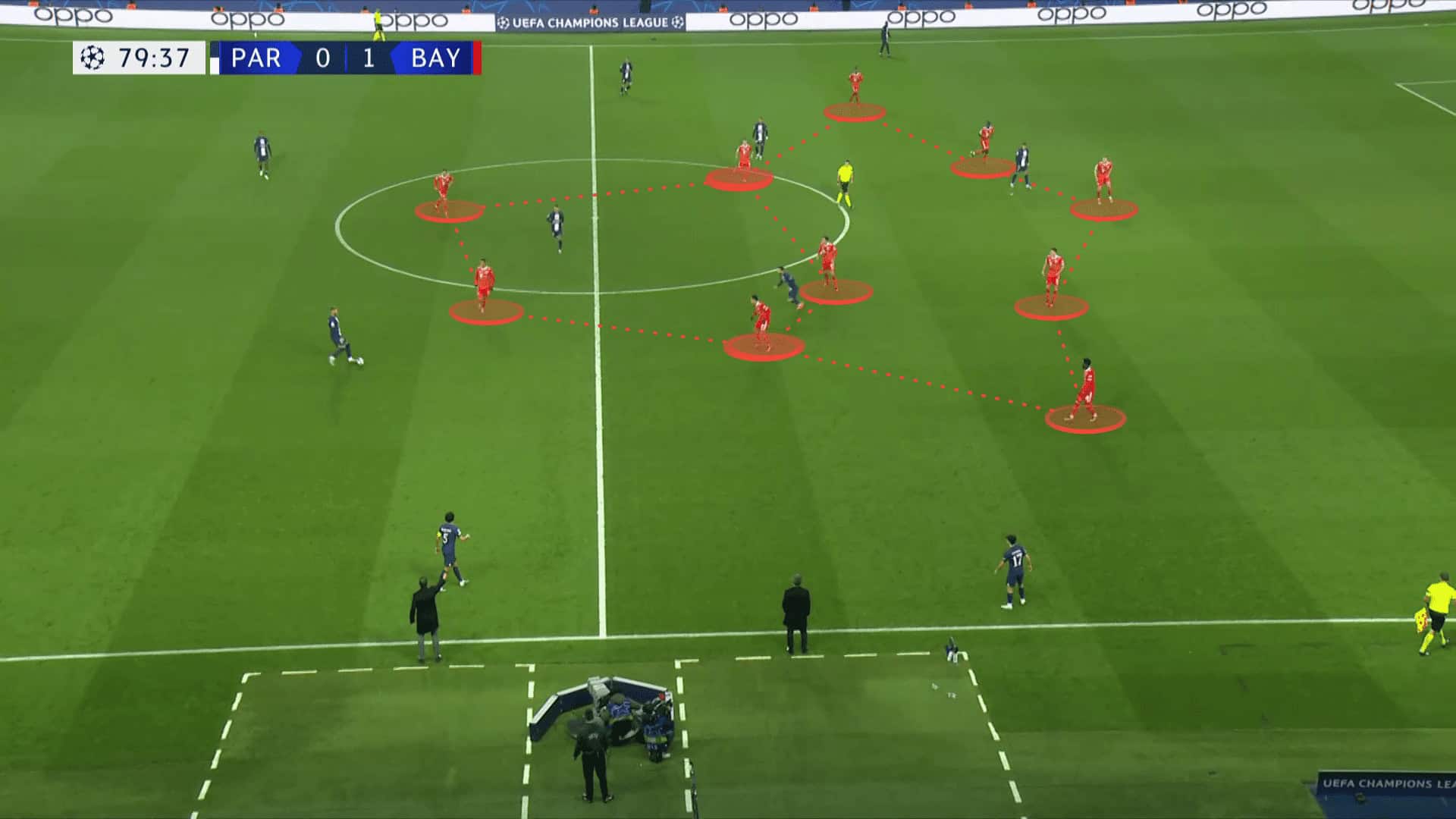 Bayern are resting in a 5-3-2 defensive block
Bayern are resting in a 5-3-2 defensive block
This withdrawal of Bayern is reflected in Paris’ ruled-out goal. The quality of Mendes and Mbappe and their pace is amazing.
Conclusion
Bayern’s victory was due to their excellent tactical analysis and execution, as well as the defenders’ outstanding performance. Julian Nagelsmann brilliantly asserted his tactical victory over Christophe Galtier.
Let us see what will happen in Allianz Arena when Mpabbe, Leo Messi and Neymar all start.

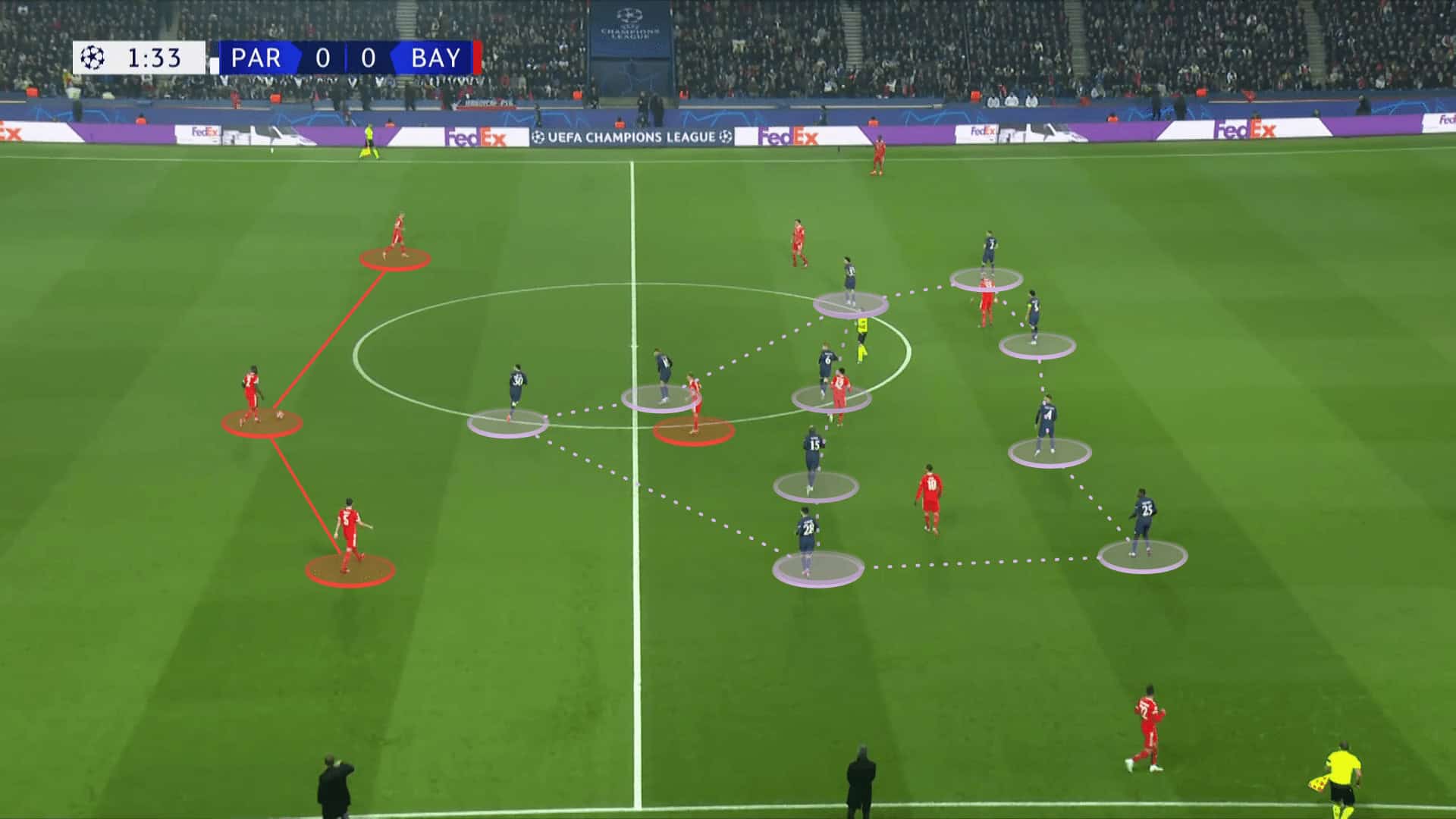



Comments